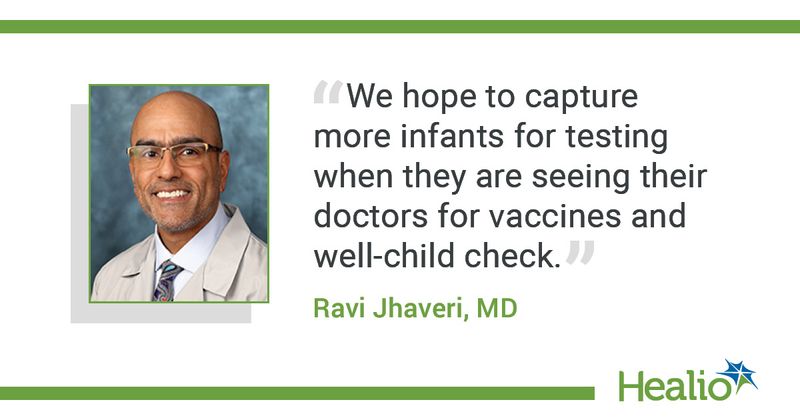Q&A: CDC recommends testing all children exposed to hepatitis C
Key takeaways:
- In new guidelines, the CDC recommends testing all infants and children who were perinatally exposed to hepatitis C.
- This includes children aged older than 18 months who have never been tested.
The CDC this week recommended hepatitis C testing for all infants or children who were perinatally exposed to the virus by a pregnant person with a current or probable HCV infection.
Writing in MMWR, the authors of the recommendations defined a current HCV infection as anyone with detectable HCV RNA, and a probable infection as someone with a reactive anti-HCV test and unavailable HCV RNA results.

The new recommendations, as outlined by the authors in MMWR, are as follows:
- Perinatally exposed infants should receive a nucleic acid test (NAT) for HCV RNA at age 2 to 6 months to identify children in whom chronic HCV infection might develop if not treated.
- Infants with detectable HCV RNA should be managed in consultation with a health care provider with expertise in pediatric hepatitis C management.
- Infants with an undetectable HCV RNA result do not require further follow-up unless clinically warranted.
- Infants and children aged 7 to 17 months who are perinatally exposed to HCV and have not previously been tested should receive a NAT for HCV RNA.
- Children aged 18 months or older who are perinatally exposed to HCV and have not previously been tested should receive an anti-HCV test with reflex to NAT for HCV RNA.
We spoke with experts Lynn Yee, MD, a maternal fetal medicine specialist and director of the Northwestern Medicine Women’s Infectious Disease Program, and Ravi Jhaveri, MD, division head of infectious diseases at Lurie Children’s Hospital of Chicago, about the new guidance and the risks associated with HCV infection in pregnancy.

Healio: Providers might be unaware of the risks of HCV in pregnancy. What are the health consequences?
Yee: In addition to the risks of HCV that all people experience — such as liver fibrosis, cirrhosis and cancer — there are some pregnancy-specific risks. First, there is an association between HCV and an increased risk of preterm birth, intrahepatic cholestasis of pregnancy and inadequate fetal growth. In addition, there are some studies that suggest an increased risk of gestational diabetes, although this is less clear. Second, for the fetus and neonate, there is a 5% to 15% risk of transmission of HCV, which poses potential lifelong risks to the child, particularly if unrecognized.
Healio: What are the biggest changes in the CDC’s recommendations, and what have been some of the biggest developments since the last time they were updated?
Jhaveri: By emphasizing testing early in life for infants with HCV exposure, we hope to capture more infants for testing when they are seeing their doctors for vaccines and well-child check. Eliminating the long delay — 18 months — that existed previously should help minimize the number of infants who are lost to follow-up.
Healio: Can you break down the testing protocol for hepatitis C during pregnancy?
Yee: Based on the 2020 U.S. Preventive Services Task Force guidelines, it is now recommended that all pregnant people be tested for HCV antibodies during routine prenatal care. This test is typically performed with their baseline prenatal labs — at the same time as testing for HIV, blood type, immunity to rubella and measles, etc. If the antibody is found to be present, then further testing is performed to investigate whether there is virus present in the blood and to evaluate liver function.
Healio: In your opinion, is there anything lacking in these recommendations?
Jhaveri: The recommendations are clear, but we still need to help pediatricians and other pediatric providers with the logistics of how to do this testing in their offices. These tactical issues will need to be worked out for practices and groups who care for these infants.
We need better coordination between pregnancy care providers and pediatric providers to make sure information is shared between them for parent-infant dyads. This will be critical to help improve on the status quo.
Healio: Why is it so crucial to include pregnant patients when researching HCV?
Yee: The inclusion of pregnant people in research programs about any condition or therapy is essential to be able to optimize the health of pregnant people and their families — without research to build the evidence on new medications, pregnant people are left behind when medical advances occur. As we learned during the early stages of the COVID-19 pandemic, when pregnant people were excluded from the SARS-CoV-2 vaccine trials, the exclusion of pregnant people leaves doctors and patients without the information we need to safely and comprehensively care for our patients.
Specific to HCV, the treatment of nonpregnant people is standard of care, and the inclusion of pregnant people in treatment and research programs is necessary to achieve the public health goal of HCV elimination. In addition, pregnant people deserve autonomy and the ability to make their own informed decisions about their health, which, for some people, may include undertaking treatment for HCV during pregnancy.
References:
Panagiotakopoulos L, et al. MMWR Morb Mortal Wkly Rep. 2023;doi: 10.15585/mmwr.rr7204a1.
